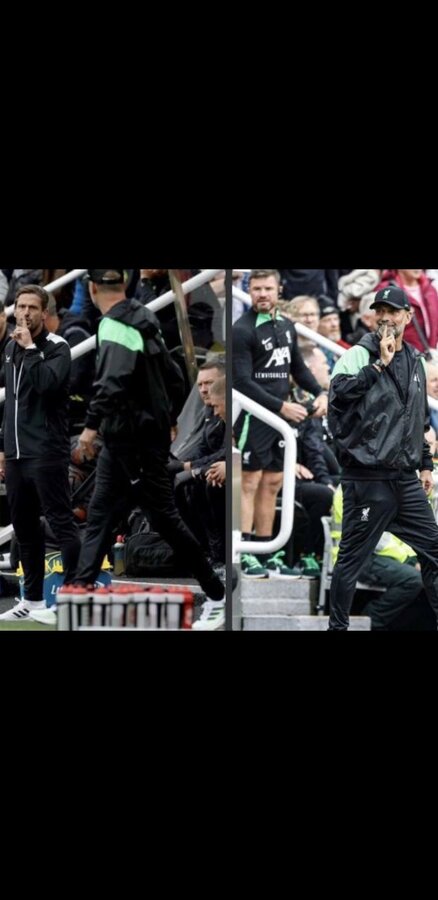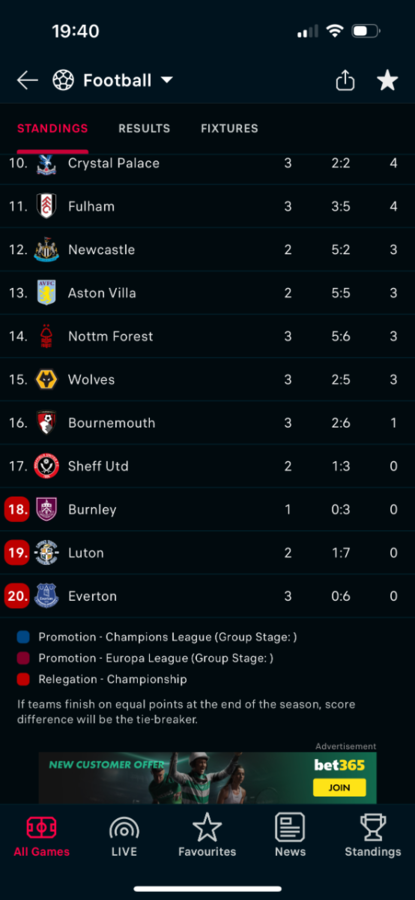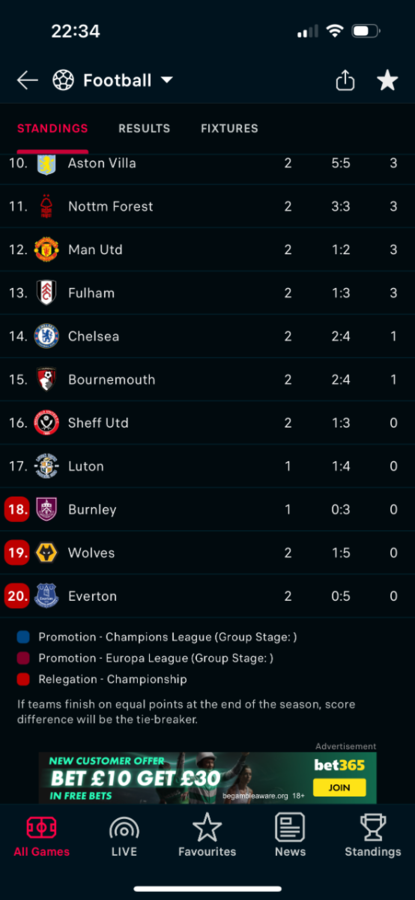-
Posts
2,781 -
Joined
-
Last visited
-
Days Won
1
Content Type
Profiles
Articles
Forums
Store
Everything posted by Baresi
-
bd7e6eab-741d-4ee5-b252-05c805c33a01.mp4
-
I fear for my liver if they go bust.
-
Can I begin to fear for them?
-
It may arrive separately. I’ve had orders that I’ve ordered, do that.
-

Halsey: Referee standards have dropped to alarming levels
Baresi replied to TLW's topic in FF - Football Forum
Paul Durkin was the best of the pro refs. -
He’s an Evertonian, how more ill can you get?!
-
Just finished it, so revised score is - 5/10. how the fuck they fucked up one of the best British tv shows, I have no idea. However, they managed to achieve it.
-
It’s 6-7/10 at best. It’s been absolutely ludicrous in parts and the earlier seasons piss all over it. An absolute letdown.
-
Deaths door - 6/10. Ragnorak next.
-
He’s staying and going to win the UEFA cup to complete the set. We will sell next year for an obscene amount and Jurgen will have a plan for his departure.
-
They have as much chance of winning it as we do.
-
The first finish is clinical. Hits the inside of the post and the look up before the strike tells you it was no fluke. Keep it up please.
-
-
85153e83-4fa3-49b0-84d9-f7cb5847e62c.mp4
-
-

Dodged a bullet with Moises Caicedo / Code says he's bang average
Baresi replied to an tha's topic in FF - Football Forum
By the way the manager has spoken about him, they have every right to take the piss, however short lived it may turn out to be. He and his entourage sound like utter bellends. -
-
Casual racism ain’t funny.
-
Hope he’s boss.
-
We need numbers. We have lost five midfielders and bought two. I haven’t seen him play, but can safely say he will more than likely offer more than both Ox and Kieta. Wait until he’s kicked a ball for us before wading in. Jesus.
-
And always go a size up.
-
Apologies for the formatting - This is from The Athletic.... For the third transfer window running, Chelsea’s spending is the talk of football. More specifically, it is Todd Boehly and Clearlake Capital’s seemingly insatiable appetite for large transfer fees that is dominating the conversation. A deal worth £115million ($146m) for Brighton midfielder Moises Caicedo has ensured that Enzo Fernandez held the British transfer record for just six months following his £106million move to Stamford Bridge. Liverpool, edged out in that pursuit, now appear to have been deprived of their secondary midfield target after Southampton’s Romeo Lavia also made his preference Chelsea in a move that will be worth £50million plus add-ons. That means Boehly and Clearlake have committed north of £300million in transfer fees on central midfielders alone in 2023 once deals for Lesley Ugochukwu and Andrey Santos are factored in. Overall the numbers are even more staggering: Lavia will take the total transfer fee commitment past the £900million mark since Chelsea’s new American owners assumed control in June 2022 — and they are not done yet. Caicedo celebrates his move alongside his mother (Photo: Darren Walsh/Chelsea FC via Getty Images) A new goalkeeper should replace the loan departure of Kepa Arrizabalaga to Real Madrid, and the club would like to add two more attackers — and all this without the revenue from a primary shirt sponsor (yet), or Champions League participation in 2023-24. No other club in the world is operating this way, and it is fair to say that Chelsea’s approach is ruffling feathers. There are growing whispers of rival clubs complaining to the Premier League about their spending, the manifestation of a broader disbelief inside and outside the game that such outlay could possibly be compliant with UEFA’s Financial Fair Play (FFP) regulations, which allow clubs to lose around €90m over a three-year period. What is more, last September they were placed on an FFP watchlist by UEFA due to the size of their losses. Yet Chelsea believe they have a strategy that will keep them on the right side of club football’s financial controls. The Athletic will endeavour to explain. You — and eventually football’s governing bodies — can then make your own mind up. Transfer fees are overrated A big obstacle to understanding what Chelsea are doing is that the way most people routinely think about football transactions — namely, by focusing almost entirely on the transfer fee — is often not the way that most football clubs think about them. And certainly not Chelsea. Here is an example: Club A signs a player for £50million and gives him a five-year contract worth £100,000 a week. Club B signs a player on a free transfer and agrees to pay him around £400,000 a week. Which player do you think is more expensive on a yearly basis? If your answer was Club B’s signing, you are on the right track. A weekly wage of £400,000 equates to an annual salary of a little more than £20million, while the total cost of an amortised £50million transfer fee over a five-year contract with a £100,000-a-week salary on the accounts is around £15million. Viewed within this context, it is very possible that the most expensive player acquisition in English football history might actually have been Erling Haaland’s move to Manchester City in the summer of 2022, once the Norwegian’s massive salary, signing-on bonus and agent fees are added to his nominally cheap £51million release fee from Borussia Dortmund. It has been widely documented that Chelsea have exploited the legal limits of amortisation (the process of spreading a transfer fee over the length of a player’s contract for accounting purposes) in order to make their spending money go further. All of their January signings were handed seven- or eight-year contracts, lowering their yearly cost on the books. Fernandez’s deal broke the British transfer record (Photo: Darren Walsh/Chelsea FC via Getty Images) UEFA ruled that, from this summer, transfer fees can only be amortised over a maximum of five years regardless of contract length, and the Premier League is likely to follow suit sooner rather than later. But even with the closure of these “FFP loopholes”, amortisation remains a powerful tool to help power Chelsea’s spending. And they’d already used the rule to good effect before the rule change came in. What is more, Chelsea will not play in European competition this season so do not have to worry about being within UEFA rules for now. They will of course hope they return next season for many reasons, but the Premier League give more leeway and therefore Chelsea more time to sort themselves out. So they believe they are all right. Others are less sure… Chelsea are selling, not just buying. But is it enough? Boehly and Clearlake have generated more than £250million from player sales in the past three transfer windows. Around £200million of that has been made this summer, primarily through the departures of Kai Havertz to Arsenal, Mason Mount to Manchester United, Mateo Kovacic to Manchester City and Kalidou Koulibaly and Edouard Mendy to Saudi Pro League clubs. That figure comes nowhere near to balancing Chelsea’s outlay on transfer fees, but for accounting purposes it does not need to. Transfer fees for player sales are registered in full on the books immediately, minus the player’s remaining amortised cost. The good news for Boehly and Clearlake is that the majority of the players they have sold in this window had either been at the club long enough to have relatively small remaining book values (Havertz, Kovacic and Christian Pulisic) or are Cobham academy graduates (Mount and Ruben Loftus-Cheek), who represent pure profit when sold. Havertz, Mount and Kovacic alone netted Chelsea close to £100million in accounting profit on player sales. That in theory could bankroll as much as £500million in transfer fees amortised over five-year contracts, without tipping the club into the red on player trading in the books. It would of course mean that income needs to consistently come in over the five years in order to keep ‘paying off’ the fees for incoming transfers. Chelsea’s estimated amortised spending in the past three windows under Boehly and Clearlake, using initial transfer figures reported by The Athletic, comes to £157.2million; this significantly lower number is almost entirely offset by an accounting profit from player sales of £149.6million over the same period. Mount was sold with all the profit banked immediately (Photo: Mike Hewitt/Getty Images) It is clear to see, then, that big clubs have more room than it might first appear to manoeuvre in the transfer market without falling foul of FFP — and the restrictions themselves are loosening; from the 2023-24 season, clubs judged to be in good financial health could be permitted to lose as much as €90million over a three-year monitoring period, triple the old limit of €30million. Because a club’s accounts are published almost a year after the relevant deals take place, it is currently too early to know if Chelsea’s current spending will see them post a loss or profit. But in terms of hitting that number over three years of about €90million loss, it is worth bearing in mind that last year’s accounts saw Chelsea post a £121million loss (€140m). The season before that saw a £156m loss (€181m), which was the second biggest in Premier League history, so the club will need to start turning a profit soon, whether that be through increased player sales, improved commercial deals or a return to the Champions League (where you’d expect to make about £3-4m per home game). Time will tell, but time is exactly what the amortisation of these transfer fees is buying the ownership. Boehly and Clearlake identified on arrival that Chelsea were ripe for a massive rebuild, with a combination of expensive players almost fully amortised on the books and an academy that produces a steady conveyer belt of saleable young footballers, as well as a handful of elite prospects good enough to become first-team contributors. But there is another key aspect to what Chelsea are trying to do… The wage bill is coming down In the course of the financial due diligence that preceded their takeover last year, Boehly and Clearlake quickly identified that Roman Abramovich had been happily paying what they regarded as a “Chelsea premium” in terms of player salaries. Base wages were well above the market rate across the board, with almost nothing tied to performance-based incentives such as Champions League participation. The massive squad turnover at Stamford Bridge over the past year has been as much about shedding contracts as players. Boehly and Clearlake have been determined to bring the club’s salary commitments down to a competitive market level, and they are well aware that the earning expectations of footballers tend to rise as they get older. Since the restructuring of their football operation around co-sporting directors Laurence Stewart and Paul Winstanley at the start of 2023, Chelsea have placed renewed emphasis on targeting players aged 23 or younger, with Christopher Nkunku (whose transfer was agreed almost a year ago), Axel Disasi and goalkeeper Robert Sanchez the only exceptions. Younger players tend to be more amenable to lower base salaries with performance incentives, which gives Chelsea the opportunity to start them at a more affordable level and then reward the best performers with pay rises as time goes by. Lavia will almost certainly be on a lower wage as he begins his career at Stamford Bridge than former Southampton team-mate James Ward-Prowse is on at West Ham. Behdad Eghbali (left) and Boehly are leaving rivals confused and concerned (Photo: Nick Potts/PA Images via Getty Images) Chelsea also remain committed to longer contracts even as amortisation benefits are reduced; Boehly and Clearlake believe they give players greater security and the club more protection on the value of their assets. It is hoped that lower salaries across the board will mean players who disappoint at Stamford Bridge will not be as difficult to offload as Romelu Lukaku and Hakim Ziyech, two of the last lavishly paid survivors of the Abramovich era. There are still some high earners on Chelsea’s books, Raheem Sterling and Nkunku chief among them. But overall Boehly and Clearlake believe they have saved tens of millions of pounds in annual salary commitments for the first-team squad — money they are re-deploying to spend on transfer fees. Chelsea’s strategy is not without risk Boehly and Clearlake have essentially re-made Chelsea’s squad as an investment portfolio: a collection of talented young footballers committed to Stamford Bridge for what should be their prime years, but whose transfer values could fall as well as rise depending on any number of variables that can affect individual development. Not all of the signings are expected to flourish, but the talent identification and development skills of the staff led by Stewart and Winstanley are being backed to ensure the successes outweigh the failures. If they do not, Chelsea will likely under-achieve on the pitch and these amortised fees will add up, limiting their options for correcting course. One of the Premier League’s oldest squads has been transformed into the youngest by owners attempting to scale up something akin to the recruitment models of Monaco, RB Leipzig and Brighton to power an elite European club. Chelsea must now balance an economic requirement to develop the young talent they have assembled for themselves and for others, with the more immediate football demands of competing at the very top of the sport. This particular tightrope has never been walked, or arguably even attempted, by a club of such size and recent winning pedigree. Can you lift the Premier League or Champions League with almost exclusively young players? Will assembling a group of players largely in the same age bracket prove an impediment to developing the kind of dressing room dynamic made possible by the best blends of youth and experience? Boehly and Clearlake are betting the answers to these questions favour them, and that their approach to transfers and squad building puts Chelsea on a path to sustained sporting success as well as financial growth. Everyone else in football will be watching closely to see what happens next.
-

When are we likely to get definitive stadium news?
Baresi replied to Nathanzx's topic in FF - Football Forum
Is the whole of the kop safe standing now? -

Dodged a bullet with Moises Caicedo / Code says he's bang average
Baresi replied to an tha's topic in FF - Football Forum
He’s so desperate to join them, all they have to do is match the bid, right? What’s holding them up? More to this than meets the eye, me thinks. Regardless of how this ends, I still fucking hate these cunts. They fucked the market when that Russian cunt bought them., and are still fucking it twenty plus years later. -

Dodged a bullet with Moises Caicedo / Code says he's bang average
Baresi replied to an tha's topic in FF - Football Forum
Just fucking bid then. Cunts.







